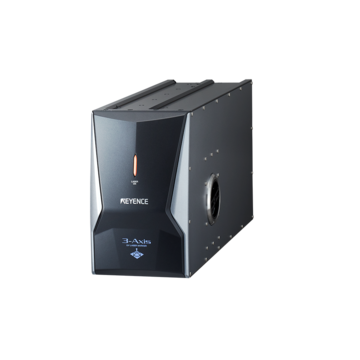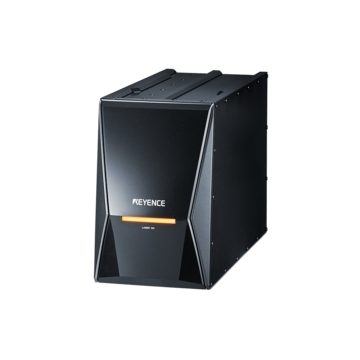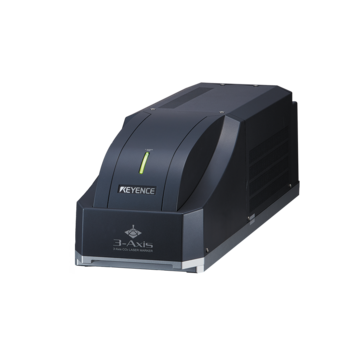Industrial Laser Marking Systems / Laser Markers
Laser Engraving on Plastic Sheets
-
Tags:
- Plastic , Laser Labeling , Laser Marking
Among the many marking options, including hand engraving, dot peening, ink printing, chemical etching, and laser engraving, one choice consistently stands out: laser engraving. Laser engraving is recognized for being contactless, high-speed, and permanent. It’s also known for its use on a wide range of materials and products, including plastic sheeting.
Together, laser engraving and plastic sheets are a perfect match. The speed of laser engraving complements the mass production and low cost of plastic. The permanence partners well with the material’s durability to keep a long-standing mark. Finally, the no-contact engraving method is compatible with keeping a plastic in its desired shape.
In this article, we’ll explore laser engraving plastic sheets and how it’s implemented for traceability, safety, and identification marks.
Laser Engraving Process
Laser engraving plastic works by generating an amplified light in a laser marking machine. Depending on the laser marker used, the light can either heat the plastic instantly to create the engraving or generate contrast quickly while avoiding any heat damage. When using heat for the engraving, the process is so rapid that the plastic turns from a solid to a gas immediately, leaving behind an indented mark. The engraved mark is black, white, or clear, depending on the type of plastic and its initial color.
We’re here to provide you with more details.
Reach out today!

Why Choose Lasers for Engraving Plastic Sheets
Laser engraving produces logos, numbers, text, barcodes, or 2D codes. Unlike traditional engraving, laser engraving plastic sheets is quick, force-free, and can be heat-free depending on the laser. Instead of dealing with tedious tip changes and burr correction, laser engraving allows for a consistent and repetitive process that can avoid damage to a plastic sheet.
Laser Engraving Plastic Sheets are Permanent
One reason for plastic’s popularity is its non-biodegradable, durable, and chemical-resistant properties. These characteristics call for an engraving method that lasts as long as plastic does. Fortunately, laser engraving plastic is a permanent method that withstands contamination, force, and environmental changes.
Laser Engraving Plastic Sheets is No Contact
Plastic sheets are thermoplastics. Since they’re thermoplastic, plastic sheets can be remolded with the right amount of heat or pressure. Although this characteristic means that these plastics are recyclable, it also means there’s a risk of accidental deformation when engraving with an engraving bit.
However, laser engraving plastic sheets is immune to this mistake because the engraving process does not have any contact. No pressure is added to the plastic with a laser, so the plastic remains intact while engraving.
Laser Engraving Plastic Sheets is Cost-Effective
Plastic sheets are mass-produced, cheap, and easy to manufacture, so choosing laser engraving is keeping up with the cost-effective industry. Laser engraving can add a mark in a fraction of a second and is exceptional at repetitive tasks. Also, there are no consumables like ink or tips so the running cost of a laser engraver is virtually nothing.
Discover more about this product.
Click here to book your demo.

Best Lasers to Use for Engraving Plastic Sheets
Plastic laser engraving can’t be achieved with just any laser. Plastic traps internal heat and is a reflective material, so it’s most compatible with UV, hybrid, and CO2 lasers.
UV Laser Marker
UV laser markers use a 355 nm ultraviolet wavelength generated from a 1064 nm wavelength passed through two crystals.
The 355 nm wavelength leads to significantly higher absorption and therefore can mark plastics through a photolytic degradation process. This process causes the breaking in bonds without relying on the heat effect that other lasers rely on. The strength surpasses surface level solid to liquid effects and does not add any heat.
Because no heat is used, this method is called “cold marking.” Cold marking is especially ideal for plastic because it prevents the plastic from deforming or developing burrs.
Hybrid Laser Marker
A hybrid laser combines a YVO4 and a fiber laser as one unit with a 1064 nm wavelength. Together, the single laser has a long service life with high output and deep engraving capabilities. The combination of the 1064 nm wavelength and hybrid technology generates a very high peak power which can engrave plastic with very minimal heat transfer.
CO2 Laser Marker
CO2 laser markers use a 10600 nm wavelength and rely heavily on the heat effect. Due to the longer wavelength, CO2 lasers use heat to engrave plastic with depth very quickly.
We’re here to provide you with more details.
Reach out today!

Applications That Benefit from Laser Engraving Plastic Sheets
Semiconductors
Semiconductor devices frequently use plastic sheets as a packaging material because of their resistance to contaminants, moldability, and low cost. Plastic sheets protect semiconductors from contaminants such as mold, acid, and mildew. Additionally, the moldability of a plastic sheet means that it is compatible with the uniqueness of each semiconductor. Finally, the low price of plastic sheets means that semiconductors are protected at a low cost.
Since semiconductors are used in a plethora of applications and can sometimes include hundreds of tiny components, semiconductors need plastic laser engraving for traceability and identification marks. Laser engraving gently engraves semiconductor plastic packaging with a number, barcode, or logo for easier supply chain tracing, faster recalls, and better quality assurance.
Interior Aircraft Components
The cabin interiors of aircraft benefit from plastic sheets because of their durability and low weight. Plastic sheet components withstand sanitation and food and drink spills. Window plastic sheet layers withstand pressure and temperature changes.
The aircraft industry requires marks for traceability and safety purposes, so laser engraving is an ideal method for these marks. The durability of laser engraving is equal to that of a plastic sheet aircraft component. Regardless of the change in temperature, pressure, sanitation, or contamination, the engravings will remain.
These engravings assist passengers by being permanent and high contrast markings that give safety instructions. For manufacturers, the plastic laser engraving serves as traceability marks to recall defective components and trace components through maintenance checks.
Medical Tray Sealing
Medical tray sealing is a common practice for packaging medical devices that need extra sterilization and transportation protection. These medical devices, usually medical implants, carry extreme risk of contamination or movement in a clamshell or blister packaging. The tray seal prevents the device from moving during shipping and exposure to contaminants.
In the medical industry, the FDA requires all medical devices (besides class 1 commercial devices) to have a unique device indicator (UDI). A UDI is a 2D code that stores traceability and usability information about the device. It’s required to be permanent and readable by humans and robots. Laser engraving is perfect for adding a UDI onto medical tray sealing. The no-contact method prevents any damage to the seal, and the permanency ensures the UDI meets federal regulations.
Curious about our pricing?
Click here to find out more.

Integrating Laser Engraving Plastic Sheets into Your Part-Tracing Applications
Laser engraving plastic is a permanent, no-contact, and cost-effective method for marking your plastic sheets with traceability marks. The engraving survives any environment that your plastic sheet will be in for its entire life span. Instead of unnecessary burrs, accidental deformation, or burns, laser engraving produces a clean mark.
At KEYENCE, we supply hybrid, UV, and CO2 lasers for laser engraving plastic sheets. We understand the importance of a correct traceability mark, which is why our lasers include features to ensure the perfect mark.
Our hybrid lasers are equipped with autofocus and auto-positioning for a repetitive and reliable engraving process. Once engraved, the laser uses a camera to detect any marking flaws. The image is compared to character shapes that are programmed into the laser’s software.
Additionally, the UV and hybrid lasers use a 2D code reader to grade the clarity. Together, these features keep your traceability marks compliant with your industry standards. Contact KEYENCE today to discuss your hybrid, UV, or CO2 laser engraver options.
We’re here to provide you with more details.
Reach out today!

Related Downloads
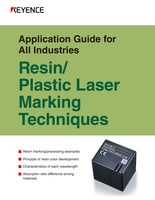
Choosing the right laser marker wavelength is extremely important for plastic marking. Learn what lasers work best for marking, processing, and coloring plastic in this guide.

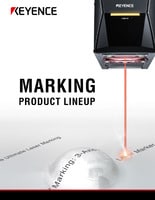
![UV Laser Marker Application Guide [High Contrast Marking]](/img/asset/AS_95184_L.jpg)
![UV Laser Marker Usage Guide [Electronic Device Edition]](/img/asset/AS_97140_L.jpg)
